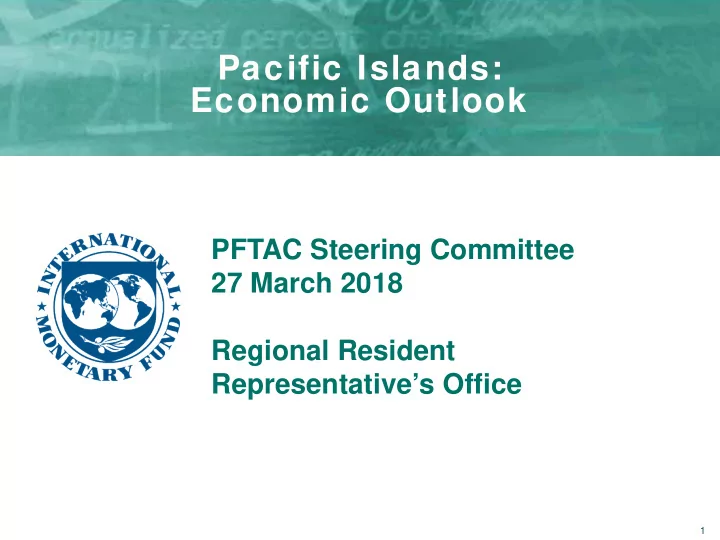

Pacific Islands: Economic Outlook PFTAC Steering Committee 27 March 2018 Regional Resident Representative’s Office 1
Recap – October 2017 WEO Projections Real GDP (percent change y/y) 2015 2016 2017 2018 2019 Fiji 3.8 0.4 3.8 3.5 3.4 Kiribati 7.5 4.2 2.8 2.3 2.3 Marshall Islands 1.9 2.0 1.9 1.8 1.7 Micronesia 3.7 3.0 2.0 1.4 0.9 Nauru 2.8 10.4 4.0 -4.0 0.2 Palau 11.4 1.9 1.0 5.5 4.5 Papua New Guinea 9.2 2.4 3.1 2.9 2.6 Samoa 1.6 7.1 2.1 0.9 1.8 Solomon Islands 2.5 3.3 3.0 3.1 2.8 Timor-Leste 4.0 5.0 4.0 6.0 6.0 Tonga 3.5 3.1 3.1 3.2 2.9 Tuvalu 9.1 3.0 3.2 2.5 2.2 Vanuatu 1.6 4.0 4.5 4.0 3.5 Source: World Economic Outlook Update, October 2017. 2
Factors affecting Pacific Island economic growth outlook and risks • External environment • Oil and commodity prices • Remittances • Natural disasters and climate change • Fishing license fees • Tourism • Correspondent banking relationships • Labor mobility (World Bank, “Pacific Possible”) • Cryptocurrency 3
Lower oil prices slowed growth for some, but also contributed to relatively low inflation Inflation - APD small states and Pacific islands, 2017 Energy prices (In USD) (Index, 2005=100) (In percent) 120 250 8 7 100 200 6 80 5 150 4 60 3 100 40 2 Crude oil, spot price 1 50 20 0 Energy price (right axis) Tonga Papua New Fiji Vanuatu Tuvalu Kiribati Samoa Palau Timor-Leste Solomon Islands Micronesia Marshall Islands 0 0 Guinea Jun-10 Dec-10 Jun-11 Dec-11 Jun-12 Dec-12 Jun-13 Dec-13 Jun-14 Dec-14 Jun-15 Dec-15 Jun-16 Dec-16 Jun-17 Dec-17 Source: World Economic Outlook. 4
Factors affecting Pacific Island economic growth outlook and risks • External environment • Oil and commodity prices • Remittances • Natural disasters and climate change • Fishing license fees • Tourism • Correspondent banking relationships • Labor mobility (World Bank, “Pacific Possible”) • Cryptocurrency 5
Remittance costs to the Pacific remain high 6
Remittance costs to the Pacific remain high 7
Factors affecting Pacific Island economic growth outlook and risks • External environment • Oil and commodity prices • Remittances • Natural disasters and climate change • Fishing license fees • Tourism • Correspondent banking relationships • Labor mobility (World Bank, “Pacific Possible”) • Cryptocurrency • Trade – Pacer Plus 8
Rise in number of natural disasters since 1980s Occurence of Natural Disasters in PICs • Forthcoming Working Paper Total occurrence of natural disasters 14 (Lee et al, 2018) Total occurrence of natural disasters (3-year moving average) 12 10 • EM-DAT database 8 • Objective: estimate effects and 6 probability of severe natural 4 disaster; build natural disaster 2 risk into baseline projections 0 1982 1984 1986 1988 1990 1992 1994 1996 1998 2000 2002 2004 2006 2008 2010 2012 2014 2016 9
Frequency of severe natural disasters has varied across countries • Preliminary estimates based on historical data for natural disasters – shows Vanuatu, Samoa particularly vulnerable. • Does not fully reflect climate change. Probability of Severe Natural Disasters in PICs Note: The size of circle denotes the probability that each country is hit by a severe (above 75 th percentile) natural disaster. 10
Factors affecting Pacific Island economic growth outlook and risks • External environment • Oil and commodity prices • Remittances • Natural disasters and climate change • Fishing license fees • Tourism • Correspondent banking relationships • Labor mobility (World Bank, “Pacific Possible”) • Cryptocurrency 11
VDS has resulted in strong growth in fishing revenue • Supporting improved fiscal Fishing License Revenue (In USD million) positions in some countries 280 260 • Opportunity to build buffers 240 and smooth spending to 220 extend benefits 200 180 160 • Fishing revenues depend on 140 weather conditions (Kiribati 120 AIV) and fish migration 100 2013 2014 2015 2016 patterns Note: Countries included are Kiribati, Marshall Islands, Micronesia, and Tuvalu 12
Factors affecting Pacific Island economic growth outlook and risks • External environment • Oil and commodity prices • Remittances • Natural disasters and climate change • Fishing license fees • Tourism • Correspondent banking relationships • Labor mobility (World Bank, “Pacific Possible”) • Cryptocurrency 13
Tourism – scope for further growth Tourist Arrival (Annual visitor number) 800,000 700,000 2013 2014 600,000 2015 2016 500,000 400,000 300,000 200,000 100,000 0 Samoa Vanuatu Palau Fiji 14
External buffers: FX reserves have increased in many countries Current Account Balance Reserve levels - changes from 2015 to 2017 (In percent of GDP) (In percent, year-on-year) 25 40.0 20 2000-15 Average 35.0 15 2016-17 Average 30.0 10 25.0 5 20.0 0 15.0 -5 10.0 -10 5.0 -15 0.0 -20 -25 -5.0 Tuvalu Tonga Palau Vanuatu Timor-Leste Samoa Nauru Solomon Islands Fiji Micronesia Marshall Islands Papua New Guinea Kiribati -10.0 -15.0 Samoa Palau Tonga Tuvalu PNG Timor-Leste Solomon Is. Fiji Vanuatu 15
Fiscal buffers: Several countries have reduced public debt Pacific Islands: Total Public Debt (In percent of GDP) 80 2017 2014 60 2012 PIC 2017 Average 40 20 0 Samoa Tuvalu Fiji Tonga Papua New Marshall Islands Vanuatu Palau Kiribati Micronesia Solomon Islands Timor-Leste Guinea 16
Integrating Surveillance and Capacity Development • Increased focus on making ensuring policy recommendations are practical and feasible • Fund CD (TA and training) supports policy recommendations / surveillance priorities • E.g. Surveillance priority: build fiscal buffers to increase resilience to shocks => Fund can provide TA on increasing fiscal revenues; improved PFM and investment management, etc. 17
IMF work agenda Themes: ⇒ Building resilience ⇒ Increasing growth Underway and upcoming, includes: • Natural disasters included in macro-frameworks and DSAs / forthcoming WP on natural disaster impact • Financial inclusion (departmental paper) • CBR • Review of low income facilities 18
Recommend
More recommend